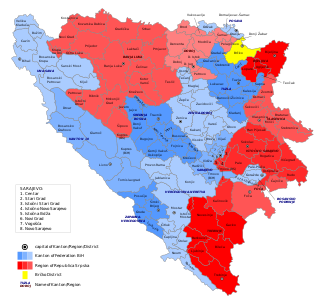Sports
- Sarajevo 84, a commonly used name for the 1984 Winter Olympics.
Sarajevo may refer to:

Gavrilo Princip was a Bosnian Serb student who assassinated Archduke Franz Ferdinand, heir presumptive to the throne of Austria-Hungary, and his wife Sophie, Duchess von Hohenberg, in Sarajevo on 28 June 1914. The killing of the Archduke and his wife set off the July Crisis, a chain of events that within one month led to the outbreak of World War I.

Sarajevo is the capital and largest city of Bosnia and Herzegovina, with a population of 275,524 in its administrative limits. The Sarajevo metropolitan area including Sarajevo Canton, East Sarajevo and nearby municipalities is home to 555,210 inhabitants. Located within the greater Sarajevo valley of Bosnia, it is surrounded by the Dinaric Alps and situated along the Miljacka River in the heart of the Balkans, a region of Southeastern Europe.

Young Bosnia refers to a loosely organised grouping of separatist and revolutionary cells active in the early 20th century, that sought to end the Austro-Hungarian rule in Bosnia and Herzegovina.
Sarajevo is a city now in Bosnia and Herzegovina.

Stari Grad is a municipality of the city of Sarajevo, Bosnia and Herzegovina. It is the oldest and most historically significant part of Sarajevo. At its heart is the Baščaršija, the old town market sector where the city was founded by Ottoman general Isa-Beg Ishaković in the 15th century.

The Sarajevo Canton, officially the Canton of Sarajevo, is one of the ten cantons of the Federation of Bosnia and Herzegovina in Bosnia and Herzegovina. Its cantonal seat is the city of Sarajevo, also the capital city of Bosnia and Herzegovina.

Muhamed Mehmedbašić was a Bosnian revolutionary and the main planner in the assassination of Archduke Franz Ferdinand, which led to a sequence of events that resulted in the outbreak of World War I.

Fudbalski klub Slavija Sarajevo is a professional association football club from the city of Istočno Sarajevo, Republika Srpska that is situated in Bosnia and Herzegovina. Slavija Sarajevo is a member of the Football Association of Republika Srpska and the Football Association of Bosnia and Herzegovina and it is active in the First League of the Republika Srpska. The club's home stadium is Gradski SRC Slavija Stadium, which has a capacity of 6,000 seats.

In Bosnia and Herzegovina, the smallest administrative unit is the municipality. Prior to the 1992–95 Bosnian War there were 109 municipalities in what was then Socialist Republic of Bosnia and Herzegovina. Ten of these formed the area of the capital Sarajevo.

Tourism in Bosnia and Herzegovina is a fast-growing sector making up an important part in the economy of the country.

The Ottoman Empire era of rule in Bosnia and Herzegovina and Herzegovina lasted from 1463/1482 to 1878 de facto, and until 1908 de jure.

The assassination of Archduke Franz Ferdinand was one of the key events that led to World War I. Archduke Franz Ferdinand of Austria, heir presumptive to the Austro-Hungarian throne, and his wife, Sophie, Duchess of Hohenberg, were assassinated on 28 June 1914 by Bosnian Serb student Gavrilo Princip. They were shot at close range while being driven through Sarajevo, the provincial capital of Bosnia and Herzegovina, formally annexed by Austria-Hungary in 1908.

Bosnia and Herzegovina fell under Austro-Hungarian rule in 1878, when the Congress of Berlin approved the occupation of the Bosnia Vilayet, which officially remained part of the Ottoman Empire. Three decades later, in 1908, Austria-Hungary provoked the Bosnian Crisis by formally annexing the occupied zone, establishing the Condominium of Bosnia and Herzegovina under the joint control of Austria and Hungary.

Sarajevo City Hall, known as Vijećnica, is located in the city of Sarajevo, Bosnia and Herzegovina. It was designed in 1891 by the Czech architect Karel Pařík, but criticisms by the minister, Baron Béni Kállay, caused him to stop working on the project. It was initially the largest and most representative building of the Austro-Hungarian period in Sarajevo and served as the city hall.

The anti-Serb riots in Sarajevo consisted of large-scale anti-Serb violence in Sarajevo on 28 and 29 June 1914 after the assassination of Archduke Franz Ferdinand. Encouraged by the Austro-Hungarian government, the violent demonstrations assumed the characteristics of a pogrom, which led to ethnic divisions that were unprecedented in the city's history. Two Serbs were killed on the first day of the demonstrations, and many others were attacked. Numerous houses, shops and institutions owned by Serbs were razed or pillaged.
The following is a timeline of the history of the city of Sarajevo, Bosnia and Herzegovina.

The campaign to establish Austro-Hungarian rule in Bosnia and Herzegovina lasted from 29 July to 20 October 1878 against the local resistance fighters supported by the Ottoman Empire. The Austro-Hungarian Army entered the country in two large movements: one from the north into Bosnia, and another from the south into Herzegovina. A series of battles in August culminated in the fall of Sarajevo on the 19th after a day of street-to-street fighting. In the hilly countryside a guerrilla campaign continued until the last rebel stronghold fell after their leader was captured.

Džidžikovac, (from "džidži" Bosnian pronunciation for Ottoman Turkish: güzel; in Bosnian: nagizdan, nađiđan, lijep; or transl. picturesque), is a neighborhood in Sarajevo, Bosnia and Herzegovina, and since 2008 a National Monument of Bosnia and Herzegovina

Proton Theatre is an independent company based in Hungary. It was founded in 2009 and is operating according to the production concept shaped by Kornél Mundruczó and Dóra Büki. The virtual artistic group is organized around the director's independent productions.